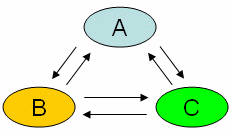Test Condition Description
Let's say we have three products namely
Product A, Product B and Product C

The DefineInterferenceComputation function
searches for interferences combining all pairs of products:
-
Product A vs. Product B
-
Product A vs. Product C
-
Product B vs. Product A
-
Product B vs. Product C
-
Product C vs. Product A
-
Product C vs. Product B
If products A, B and C are assigned the
same product type and we are checking the same
representations, the system performs useless double checks.
Now, if we consider the same three products
using the > test condition, the interference
checking will be performed between the following scheme: Product A
> Product C > Product B. |
![]()